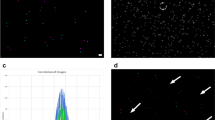Abstract
The correlation coefficient r is a measure of similarity used to compare regions of interest in image pairs. In fluorescence microscopy there is a basic tradeoff between the degree of image noise and the frequency with which images can be acquired and therefore the ability to follow dynamic events. The correlation coefficient r is commonly used in fluorescence microscopy for colocalization measurements, when the relative distributions of two fluorophores are of interest. Unfortunately, r is known to be biased understating the true correlation when noise is present. A better measure of correlation is needed. This article analyses the expected value of r and comes up with a procedure for evaluating the bias of r, expected value formulas. A Taylor series of so-called invariant factors is analyzed in detail. These formulas indicate ways to correct r and thereby obtain a corrected value free from the influence of noise that is on average accurate (unbiased). One possible correction is the attenuated corrected correlation coefficient R, introduced heuristically by Spearman (in Am. J. Psychol. 15:72–101, 1904). An ideal correction formula in terms of expected values is derived. For large samples R tends towards the ideal correction formula and the true noise-free correlation. Correlation measurements using simulation based on the types of noise found in fluorescence microscopy images illustrate both the power of the method and the variance of R. We conclude that the correction formula is valid and is particularly useful for making correct analyses from very noisy datasets.
Similar content being viewed by others
References
Bretzner, L.: Multi-scale feature tracking and motion estimation. Dissertation, Royal Inst. of Tech., Stockholm, Sweden. TRITA-NA-P99/07, Dept. of Numerical Analysis and Computing Science (1999)
Pahlavan, K., Uhlin, T., Eklundh, J.-O.: Integrating primary ocular processes. In: Proc. of ECCV 1992, May (1992)
Shapiro, L.S., Wang, H., Brady, M.: A corner matching and tracking strategy applied to videophony. Tech. Report OUEL 1933/92, Robotics Research Group, Univ. of Oxford (1992)
Francisco, A., Bergholm, F.: On the importance of being asymmetric in stereopsis—or the use of skewed parallel cameras. Int. J. Comput. Vis. 29(3), 181–202 (1998) (Authors in random order)
Manders, E.M.M., Verbeek, F.J., Aten, J.A.: Measurement of co-localization of objects in dual-colour confocal images. J. Microsc. 169, 375–382 (1993)
Adler, J., Pagakis, S., Parmryd, I.: Replicate based noise corrected correlation for accurate measurements of colocalization. J. Microsc. 230, 121–133 (2008)
Adler, J., Parmryd, I.: Correlation between sets of data. Patent application in Sweden Nr. 0602596-9. Filed November 29th (2006)
Adler, J., Parmryd, I., McKay, I., Pagakis, S.N.: On the quantification and display of colocalisation. Abstract at the Focus on Microscopy meeting, Genua, Italy (2003)
Spearman, C.: The proof and measurement of association between two things. Am. J. Psychol. 15, 72–101 (1904)
Spearman, C.: Correlation calculated from faulty data. Br. J. Psychol. 3, 271–295 (1910)
Udny, Y.G.: (October 1908) Private letter to Spearman, which later became Appendix E: “Yule’s proof of the correction formula” in Spearman (1910)
Udny, Y.G., Kendall, M.G.: An introduction to the Theory of Statistics, 14th edn. Charles Griffin, London (1950). pp. 313–314, 327–328
Muchinsky, P.M.: The correction for attenuation. Educ. Psychol. Meas. 56(1), 63–75 (1996)
Wilcox, R.: Modern insights about Pearson’s correlation coefficient and least squares regression. Int. J. Sel. Assess. 9(1–2), 195–205 (2001)
Qin, G.Y., Zhu, Z.Y., Fung, W.K.: Robust estimating equations and bias correction of correlation parameters for longitudinal data. Comput. Stat. Data Anal. 52(10), 4745–4753 (2008)
Argyros, A., Lourakis, M., Trahanias, P.E., Orphanoudakis, S.: Independent 3D motion detection through robust regression in depth layers. In: Proc. 7th British Mach. Vision Conf. (BMVC 1996), pp. 535–544, Edinburgh, UK, Sept 9–12 (1996)
Terzopoulos, D., Witkin, A., Kass, M.: Constraints on deformable models: recovering 3D shape and non-rigid motion. Artif. Intell. 36, 91–123 (1988)
Råde, L., Westergren, B.: BETA, Mathematics Handbook, 2nd edn. Chartwell Bratt (1990)
Kmenta, J.: Introduction to Econometrics. Macmillan, New York (1971)
Brownlee, K.A.: Statistical Theory and Methodology in Science and Engineering. Wiley, New York (1960)
Author information
Authors and Affiliations
Corresponding author
Rights and permissions
About this article
Cite this article
Bergholm, F., Adler, J. & Parmryd, I. Analysis of Bias in the Apparent Correlation Coefficient Between Image Pairs Corrupted by Severe Noise. J Math Imaging Vis 37, 204–219 (2010). https://doi.org/10.1007/s10851-010-0200-z
Published:
Issue Date:
DOI: https://doi.org/10.1007/s10851-010-0200-z




